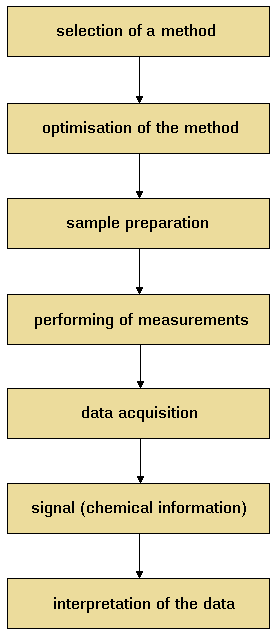| Fundamentals of Statistics contains material of various lectures and courses of H. Lohninger on statistics, data analysis and chemometrics......click here for more. |

|

Home  General Processing Steps General Processing Steps  The Analytical Process The Analytical Process |
|||
The Analytical Process
The following example should clarify the analytical process: Suppose we have to determine the trace elements in a food sample. To this end we have many methods in principle available to us, e.g. neutron activation, ICP emission, atom absorption, etc. Choosing a certain method always represents a compromise that depends on the availability of the equipment, the cost of the method (both time and effort), the achievable accuracy and the detection limit. In this example if one chooses AAS (atom absorption), then one must next establish the type of measurement and the appropriate sample preparation. In most cases the first measurement needs to be optimized (which can sometimes be very tedious) before the ''actual'' measurement is carried out. In most cases the measurement itself yields an electrical signal, which must be processed accordingly (filter out noise, bandlimiting) before it can be digitalised. The obtained data must then be converted into chemical data with the help of a calibration function. The work is not yet completed in most cases. The next step is data interpretation. Chemometrics is applied at every step of the analytic process with the exception of sample processing and the measuring. Here the trend toward overall integration works in so far as the sample processing, the measurement instrument, and the collection and interpretation of data are all incorporated for routine measurements into a common shell (medical analysis automations are a good example of this).
|
|||
Home  General Processing Steps General Processing Steps  The Analytical Process The Analytical Process |
|||


